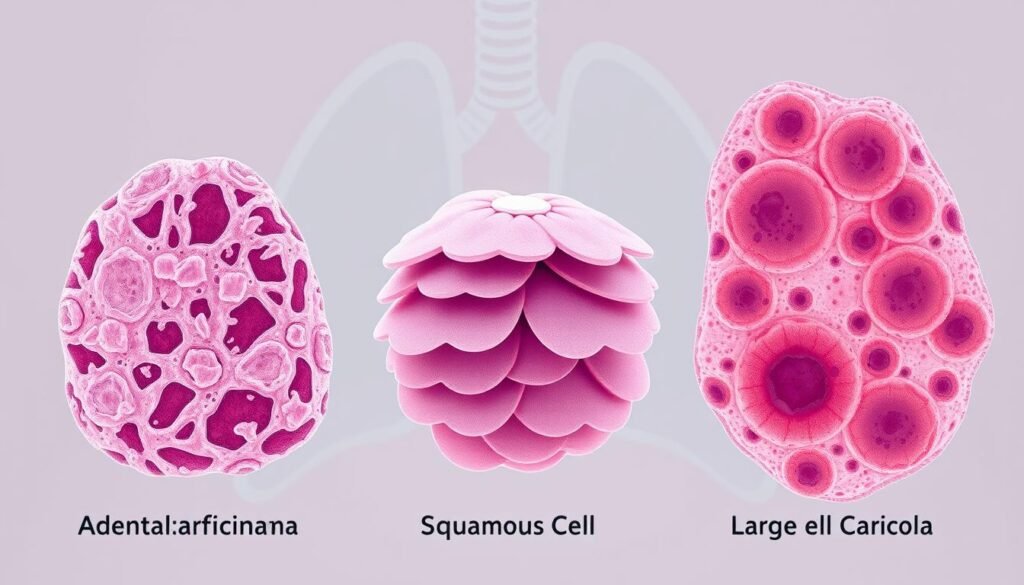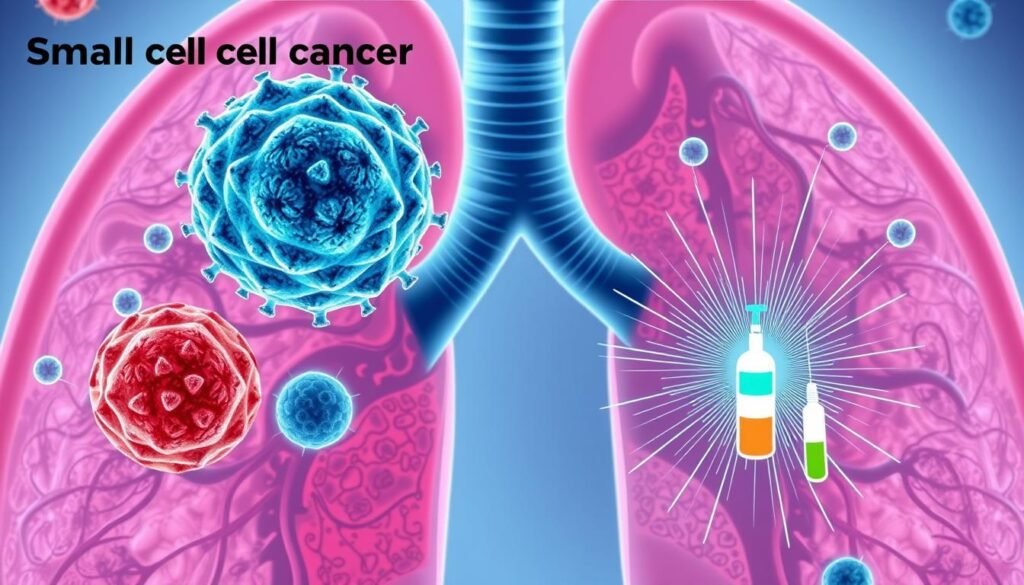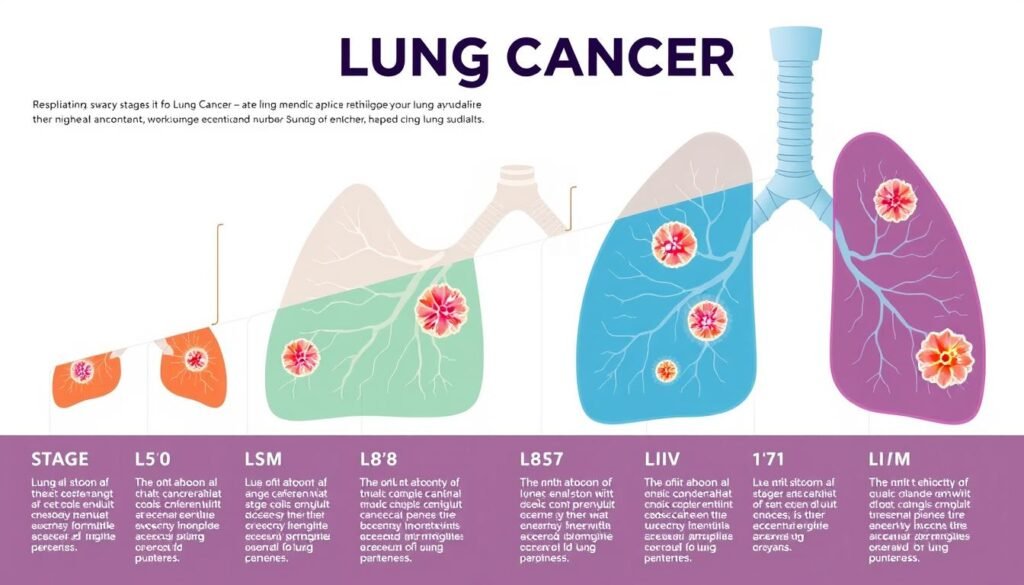Did you know nearly 90% of lung cancers are non-small cell type? This fact shows why it’s so important to know about the different lung cancers. Lung cancer is the second most diagnosed cancer in the U.S., affecting about 222,500 people every year. Knowing the common cell types helps doctors find the best treatments.
Lung cancer mainly comes in two types: small cell (SCLC) and non-small cell (NSCLC). NSCLC is more common, including adenocarcinoma, squamous cell carcinoma, and large cell carcinoma. Each type grows and responds to treatment differently. That’s why knowing the exact type is key for good patient care.
For more detailed info on these cancers, including the rare types, check out this resource here. Understanding these can improve treatments and educate patients better.
Key Takeaways
- Non-small cell lung cancer accounts for nearly 90% of all lung cancer cases.
- Adenocarcinoma is the most prevalent lung cancer type, representing about 30% of all cases.
- Squamous cell lung cancer is responsible for approximately 30% of non-small cell lung cancers.
- Understanding the types of lung cancer is crucial for effective diagnosis and treatment planning.
- Identifying specific cell variants can significantly impact prognosis and treatment outcomes.
Introduction to Lung Cancer
Lung cancer is a major health issue as a malignancy that starts in the lungs. It shows up in many forms. This makes what doctors call a complex lung cancer overview.
There are two main kinds of lung cancer: non-small cell and small cell. Non-small cell lung cancer (NSCLC) is the more common type. It’s often linked to genetic mutations, especially in adenocarcinoma. Small cell lung cancer (SCLC), on the other hand, is mostly caused by smoking. This highlights the need to stop smoking to prevent it.
Knowing the types of lung cancer helps with its diagnosis and treatment. Finding it early helps treat it more effectively. It’s important to know the types to make the best treatment plan for each patient.
In the U.S., lung cancer kills more women than any other cancer. This shows how critical it is to be aware and get diagnosed early. People, especially those at higher risk, should watch for symptoms and get screened on time. Doing so helps catch the disease early and treat it quickly.
Understanding Lung Cancer Types
Lung cancer falls into two main groups: small cell lung cancer and non-small cell lung cancer. Each has its own traits, growth rates, and common demographics. Small cell lung cancer (SCLC) makes up about 10-15% of these cases. It’s mostly seen in smokers. SCLC spreads quickly and comes in two types: small cell carcinoma and combined small cell carcinoma. This fast growth can limit treatment choices and outcomes.
On the other hand, non-small cell lung cancer (NSCLC) makes up roughly 85-90% of lung cancer cases. It includes three subtypes: lung adenocarcinoma, squamous cell lung cancer, and large cell lung cancer. Knowing the type of lung cancer is key to picking the right treatment. Adenocarcinoma, which is about 40% of NSCLC cases, usually starts in the outer parts of the lungs. Squamous cell carcinoma tends to start in the bronchi at the lung’s center.
For more details about lung cancer types, check out this resource. Understanding the differences helps doctors create specific treatment plans. This can improve predictions and care for their patients.
| Type of Lung Cancer | Percentage of Cases | Characteristics |
|---|---|---|
| Non-Small Cell Lung Cancer (NSCLC) | 85-90% | Includes adenocarcinoma, squamous cell lung cancer, and large cell lung cancer; slower growth. |
| Small Cell Lung Cancer (SCLC) | 10-15% | Rapid growth; includes small cell carcinoma and combined small cell carcinoma; primarily linked to smoking. |
Non-Small Cell Lung Cancer (NSCLC)
Non-small cell lung cancer is the top type of lung cancer. It makes up almost 90% of all lung cancer cases. NSCLC grows slower than small cell lung cancer. There are three main types: adenocarcinoma, squamous cell carcinoma, and large cell carcinoma.
Adenocarcinomas start in the lungs’ outer parts. They are about 40% of non-small cell lung cancer cases. Women and people who don’t smoke get this type more often. Squamous cell carcinomas form near the bronchus. They are about 30% of NSCLC cases. Large cell carcinomas grow fast and can be anywhere in the lungs. They are 10-15% of the cases.
The treatment for non-small cell lung cancer depends on the type and stage. Surgery works well if the cancer hasn’t spread to the lymph nodes. In more advanced stages, doctors use chemotherapy and targeted therapies. Early detection is key. It can lead to effective surgery, while late detection might need chemo and radiation. The outcome depends on many factors, including how early the cancer is found.
| NSCLC Type | Location | Percentage of Cases |
|---|---|---|
| Adenocarcinoma | Outer regions | 40% |
| Squamous Cell Carcinoma | Central area next to bronchus | 30% |
| Large Cell Carcinoma | Any part of the lung | 10-15% |
Adenocarcinoma, Squamous Cell, and Large Cell Types
Lung cancer includes different cell types. Adenocarcinoma, squamous cell carcinoma, and large cell carcinoma are three main kinds. They are part of non-small cell lung cancer (NSCLC). Knowing about these types helps us understand how they are different and how to treat them.
Overview of Adenocarcinoma
Adenocarcinoma is the most common lung cancer, making up about 40% of cases. It starts in the mucus-making cells in the outer lung areas. More women and non-smokers get this type. It grows slowly, which sometimes leads to late discovery. Genetic changes and environmental toxins play a role in causing it.
Characteristics of Squamous Cell Carcinoma
Squamous cell carcinoma represents 25-30% of lung cancers. It’s found mainly in the central airways. Smoking is a big risk factor for this type. Symptoms like coughing and wheezing are common. Knowing how squamous cell carcinoma behaves helps in managing it. Treatments include surgery, radiation, and chemotherapy.
Details on Large Cell Carcinoma
Large cell carcinoma accounts for 5-10% of lung cancers. It’s a group of fast-growing tumors. They can start anywhere in the lungs and spread quickly. Sadly, the survival rate is not high, around 6-10 months for advanced stages. Early surgery, and sometimes radiation or chemotherapy, can manage this cancer.
| Type of Lung Cancer | Percentage of Cases | Common Characteristics | Lung Cancer Treatment Options |
|---|---|---|---|
| Adenocarcinoma | 40% | Slow growth, common in non-smokers | Surgery, targeted therapy, chemotherapy |
| Squamous Cell Carcinoma | 25-30% | Located in central airways, linked to smoking | Surgery, radiation, chemotherapy |
| Large Cell Carcinoma | 5-10% | Aggressive, rapid growth, poor prognosis | Surgery, chemotherapy, radiation |

Histological Subtypes of Lung Cancer
Studying tissue samples under a microscope is key to understanding lung cancer. It helps identify the type of lung cancer accurately. This is crucial for choosing the right treatment.
Knowing the specific subtype affects how a patient is cared for. It is especially important for personalized medicine, where treatments are tailored to the individual.
Definition and Importance of Histopathology
Histopathology reveals the different subtypes of lung cancer. For example, adenocarcinoma and squamous cell carcinoma have unique features. These features affect a patient’s outlook and treatment options.
Identifying the exact subtype is vital. It can greatly impact how well a patient does with their cancer treatment.
Common Histological Variants in NSCLC
Adenocarcinoma is the most common subtype in NSCLC, especially in women. While 39% of men and 57% of women have this form, squamous cell carcinoma is seen in 25% of men and 12% of women. Other types like large cell carcinoma and adenosquamous carcinoma are less common.
Each variant affects treatment choices and how patients are managed. Understanding these helps doctors provide better care.
| Histological Subtype | Percentage (Males) | Percentage (Females) | Age-Standardized Incidence Rate (per 100,000 person-years) |
|---|---|---|---|
| Adenocarcinoma | 39% | 57% | 12.4 (males), 8.3 (females) |
| Squamous Cell Carcinoma | 25% | 12% | 7.7 (males), 1.6 (females) |
| Large Cell Carcinoma | 8% | 6% | 2.6 (males), 0.9 (females) |
| Small Cell Carcinoma | 11% | 9% | 3.6 (males), 1.3 (females) |
| Adenosquamous Carcinoma | Varies | Varies | Data not specified |
Small Cell Lung Cancer (SCLC)
Small cell lung cancer is one of the toughest lung cancers known. It grows fast and spreads early. It’s often caused by smoking, though not always. Knowing about SCLC characteristics helps catch it early. This cancer comes in two types: small cell carcinoma and combined small cell carcinoma.
People with small cell lung cancer usually have a hard fight ahead. How long someone might live depends on when the cancer is found. If it’s just in one spot, the 5-year survival rate is about 30%. If it has moved to nearby lymph nodes, that drops to 18%. And if it’s spread far, like to other organs, the chance drops to 3%. On average, people live 1 to 2 years after finding out they have it.
Treatment often involves chemo and radiation to try to control the cancer. Sometimes, doctors might do surgery if they catch it really early. Lately, there’s hope with immunotherapy too. This shows we need more research to find better treatments for SCLC.

Rare Types of Lung Cancer
Some lung cancers are rare and hard to deal with. Carcinoid tumors and mediastinal tumors are unique. They need special attention for the right lung tumor types and lung cancer classification.
Carcinoid Tumors
Carcinoid tumors are unusual neuroendocrine growths found in the lungs. They are grouped into typical and atypical types. Typical ones grow slowly, while atypical ones are faster and more dangerous. Surgery is often the best treatment, helping many achieve good results. For more info, check out lung carcinoid treatment options.
Mediastinal Tumors
Mediastinal tumors grow in the chest’s mediastinum area. They can be benign or malignant, affecting treatment and outlook. How to treat Mediastinal tumors closely relates to their kind and spot. Benign tumors usually need less forceful treatment than malignant ones. Knowing how they affect lung function is key.
Cancer Staging and Its Importance
Cancer staging is key in knowing how serious lung cancer is. It helps doctors plan treatments and predict outcomes. They use the TNM system to stage non-small cell lung cancer (NSCLC), which stands for Tumor, Node, and Metastasis.
The TNM staging considers three main factors:
- T (Tumor): Describes the original tumor’s size and place.
- N (Node): Shows if cancer has reached nearby lymph nodes.
- M (Metastasis): Checks if cancer has spread far from the start point.
The staging system ranks lung cancer from 0 to IV. Stage 0 means the cancer hasn’t spread. Higher stages show more advanced cancer. For instance, Stage I cancer is small and stays in one lung. Stage IV cancer has spread far, affecting how doctors treat it and what they expect to happen.
Understanding staging is crucial for choosing treatments and guessing patient outcomes. NSCLC and small cell lung cancer (SCLC) each have their staging system. NSCLC goes from Stage I to IV. SCLC is simply early-stage or late-stage. This reflects their different growth and treatment needs.

Staging gives doctors a full picture of a patient’s cancer, including the tumor’s size and spread. This helps them find better ways to treat it.
| Stage | Description | Lung Cancer Prognosis |
|---|---|---|
| 0 | In situ; cancer has not spread | High survival rate |
| I | Small primary tumor, not spread to lymph nodes | Favorable prognosis |
| II | Tumor localized in the lung, no metastasis | Improved outcomes |
| III | Spread within the chest, not to distant sites | Variable prognosis based on subtype |
| IV | Cancer has spread to distant organs | Lower survival rates |
As cancer research gets better, the staging system updates. This keeps track of how lung cancer grows. Proper staging is a must for the right treatment plan and for knowing how long patients might live.
Treatment Strategies for Lung Cancer
Lung cancer treatment combines different methods. It depends on the patient’s health and cancer stage. Surgery, radiation, and chemotherapy are the main treatments used. Surgery aims to remove the tumor completely, offering a chance for a cure.
Surgery, Radiation, and Chemotherapy Approaches
Treatment choices impact the patient’s health. Surgery is best for early-stage cancers. Radiation is important for those who can’t have surgery. Advanced radiation techniques like SBRT are very precise. They target the cancer without harming healthy tissue. Learn more about radiation treatments here.
Chemotherapy is used alone or after surgery to kill any remaining cancer. The choice of treatment depends on the cancer type, tumor characteristics, and the patient’s health.
Emerging Treatments and Clinical Trials
New treatments for lung cancer are being developed. Immunotherapy and targeted therapies are promising. They help the immune system fight cancer or block cancer growth. Joining clinical trials gives access to the latest treatments.
These new treatments offer hope and could improve survival with lung cancer.
| Treatment Strategy | Indications | Potential Outcomes |
|---|---|---|
| Surgery | Early-stage lung cancer | Curative potential, improved survival rates |
| Radiation Therapy | Able to undergo surgery, localized disease | Localized tumor control, minimal side effects |
| Chemotherapy | Advanced stage, residual cancer post-surgery | Reduction in tumor size, prolonging survival |
| Immunotherapy | Advanced cancer stages | Enhances immune response, potential for prolonged remission |
| Targeted Therapies | Specific genetic markers present | Increased effectiveness, reduced side effects |
Prognosis Factors in Lung Cancer
Understanding how prognosis factors affect lung cancer is key to knowing survival chances. Factors like cancer type, how early it’s found, and how well treatment works are critical. The two main lung cancers, NSCLC and SCLC, show different survival outcomes.
A study on large cell carcinoma (LCC) patients showed lower survival compared to other NSCLCs. Most patients were diagnosed late, at stages III/IV, linking late finding to worse outcomes. Stage I patients lived an average of 42 months, but stage IV patients only about three months.
Things like age, gender, and where the tumor is can affect survival. Early surgery can greatly help, especially in stages I to III LCC. It cuts the death risk by 60% versus getting no surgery. Though helpful, chemotherapy’s success drops as the cancer progresses.
Adjuvant chemotherapy helps reduce death risk in stages II–III NSCLC by around 20%. But surgery is still the best shot for a cure, especially at early stages. Stage Ia survival can be as high as 50% or 73%, depending on the kind of staging. But at stage IV, survival drops to just 2%.
Factors like lymph node involvement and tumor size matter a lot for prognosis. Having cancer spread to only one place can mean better survival than if it spreads to many. The role of very small metastases in survival is still being studied.
The way prognosis factors interact with lung cancer survival stresses the need for tailored treatments. Understanding these relationships helps doctors target their treatments better for each lung cancer patient.
Conclusion
Understanding lung cancer’s complex landscape is key for effective management. There are different types, like lung adenocarcinoma and squamous cell carcinoma. They have their own features. It’s important to choose treatments that match the tumor’s specific traits. This summary shows how diverse lung cancer can be. It also talks about how important molecular subtyping is for choosing the right therapy.
Recent studies highlight the importance of immune cell expression and tumor biomarkers in deciding on treatment. For example, studying immune cell interactions helps doctors predict immune responses. This may lead to personalized immunotherapy. With precision medicine advancing, treating lung cancer is looking more hopeful.
Being aware of current research and new developments in lung cancer treatment helps patients and families. Scientists are making progress in understanding lung cancer’s biology and finding better treatments. Knowing about these advancements helps improve care and patient outlook. It’s crucial for patients to use reliable sources and follow expert advice for better navigation through their treatment journey.